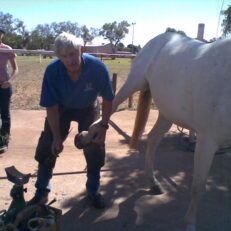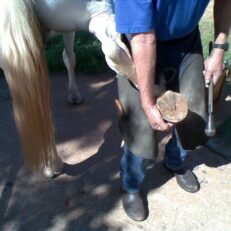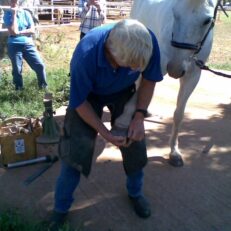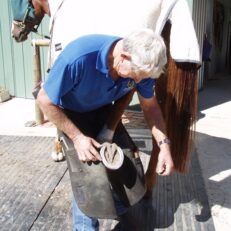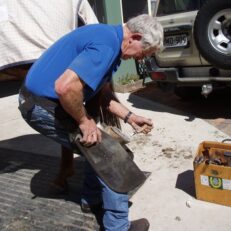I invite feedback from all my course participants and a recent feedback email gave me a jolt. It read “Changing from a participant to a viewer this time was lucky for me in a way as it allowed me to be in the right place at the right time (ie not under my horse) to pick up a great piece of knowledge from David that has enabled me to solve ongoing mystery injuries with my horses. David mentioned that if a horse won’t stand still when a farrier is doing the front feet to look at where the farrier is standing. He said that quite a few farriers pick up the horse’s leg then drag it out to the side to work on it; an unnatural and often painful position for the horse which means they will often try to ‘escape’ the situation. Well, the chiropractor has been telling me for ages that my horses have torn/scarred pectorals (which I found odd since they are very quiet, not in work and we have no slippery areas). My farrier came on Friday and I noticed, yes, he drags the leg out to the side and hangs on to it when the horse rears in response to the pain. I saw immediately how this ongoing damage to all my horses’ pectorals is occurring and how they are re-injured every six weeks.”
This is a really sad state of affairs and can be the result of a combination of several factors all of which involve total misunderstanding of the horse.
Horsemanship is a very important part of being a farrier. The horse is a flight animal and horses fear being trapped and will immediately get defensive. Read the body language of the horse – good trimming and shoeing is only possible by doing this.
Discomfort is part of being a farrier, and for those who are not farrier fit, you often need to be in an uncomfortable position to enable the horse to be comfortable. Fear of being close to the horse often leads to pain for the horse when the leg is pulled out too wide. Also a person who fears being kicked or struck will then tense up instead of going loose – the horse will pick up on this and become nervous.
Poor trimming and shoeing result in pain for the horse. Many horses find it impossible to stand still even on flat surfaces because their out of balance feet are causing great pain in their shoulders or back. For these horses, it is important to get one foot corrected as quickly as possible (usually the worst one in front but sometimes a hind) then the horse will allow you to correct the rest comfortably. You may often think that the recalcitrant horse is being that way through bad manners, but 98% of all these problems arise from bad feet (ie pain).
When you pick up a horse’s front leg, he has what I call a ‘Happy Spot’. This is an area of about one foot square that when you hold the foot up off the ground at the fetlock joint, there is no tension at all, and the horse is standing on his other three legs perfectly balanced and comfortable. That is the spot to work on the hoof.
However, most people then pull the leg out another foot, and then up another six inches so they can step in and work on the leg where they are comfortable. That immediately puts the horse out of his comfort zone, the hoof has been removed from its ‘Happy Spot’ and the horse will not stand there for more than a few seconds before it starts to shift its weight, pull its leg back and then get branded as an ‘idiot’ or as a ‘bad horse’. This is even more evident with a hind leg.
With a hind leg, it is picked up in exactly the same way, and you find where the horse’s leg is relaxed by simply holding the hoof and taking it out the back to find that Happy Spot – it may be a lot lower than what you expect, it could be a little bit higher, or out the back a bit further, or back under the horse a little, but wherever that relaxed spot is, that is where you work. Another tip – when working on the hind leg, the Happy Spot is when the hock is at no less than a 90 degree angle
Not all horses are comfortable with their leg held in the normal workable position. If your horse is of the mature variety and becomes agitated during the trimming or shoeing procedure, understand that he is finding it hard to flex his legs up that high any more, so lower the leg down to where he is happy and he will relax and then you may continue. I regularly shoe some older horses with their hoof no higher than 300 mm (one foot) off the ground, because they are stiff in the shoulders and hips, yet they lead an active working life.
Learn to stand in a balanced posture when working under the horse. If you push, he has to push. But if you are both balanced, you will both be able to relax and enjoy the company. Also, in order for the horse to balance when you pick up a leg, he has to be able to spread his legs. All he is doing is trying to balance. You need to allow the horse to stand square with the fourth leg in the Happy Spot.
There are now more and more people handling horses who are not natural horsemen with horse blood in their veins so to speak. Many are embarking on a horse career at a later age in life, and while they may seek tuition at riding they are lacking tuition in horsemanship which should always include handling the legs. A favourite bush terminology for them would be that they are ‘haunted’ about handling the legs and this transmits fear to a horse which creates a very dangerous situation.
I would be a liar if I said I never felt fear around any horse. However, when around horses it is necessary to transmit confidence. I found many years ago that horses cannot decode whistling, and whistling has saved me from many potentially dangerous situations.
At my courses I tell the participants to always introduce themselves to the horse, saying that they wouldn’t go up to a filly in the local mall and just pick up her leg without introducing themselves first. This always provokes a laugh, but people do tend to ignore good manners when around the legs of a horse and hopefully this will change their attitude in future.
Novice horse owners take riding lessons where they learn to sit correctly, and it is important to realise that picking up the legs takes just as much teaching and understanding to achieve mutual cooperation and respect. There are many positions for correctly handling the legs which I cover in my DVD and my courses, and it is not just a matter of standing anywhere and expecting the horse to cooperate.
When approaching a horse with a bad shoeing record I listen intently to all the negative comments put forth by the owner which would make most people fearful to proceed. I approach the horse, introduce myself to the horse in a friendly manner and explain to him that we have never met and I am not going to do anything to cause him pain, and I don’t expect him to cause me any pain. I approach him on an equal basis and afford him the respect that I also expect from him in return. Most of these horses become soft and pliable and cooperative, often yawning, licking lips, dropping their head and going to sleep. People attending horsemanship courses understand this when dealing with the top half of the horse, but promptly forget about it when handling the legs.
If you are having trouble with the horse not wanting to stand kindly while he is having shoes nailed on, then just go back and have a look what nails you are actually using. You may find it is a whole lot better to go back down a size in nails for the sake of the horse and to achieve a successful and calm completion of the job. There is absolutely no reason for a horse to become nervous or jittery when the shoes are being nailed if it is being nailed with the correct selection of nails into the correct shoe for that size hoof after the hoof has been correctly balanced.
Horses are generally very reasonable, and if a horse is fearful of having shoes nailed on, or fearful of men or fearful of lifting its leg or whatever, it almost certainly indicates a previous bad experience. It takes time and patience to win back the confidence and respect and to teach him that everything is going to be OK now.
On the rare occasion that a horse is really playing up, and won’t be persuaded to be nice, I have no hesitation in calling it quits for the day rather than persisting and spoiling a beautiful friendship.

